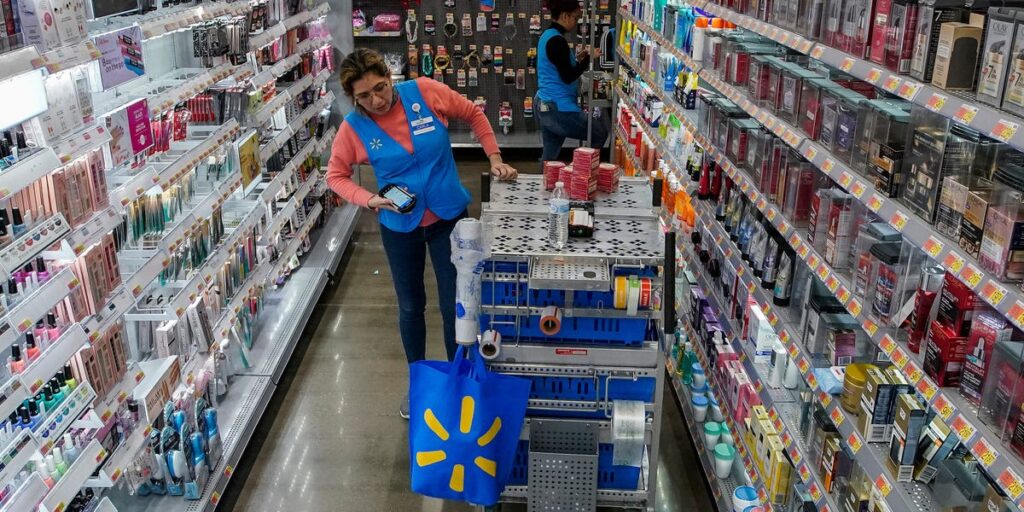- Walmart is ramping up its efforts at its 4,700 U.S. stores to fulfill orders for its growing e-commerce business.
- It's a strategy rival Target has focused on for a decade, with notable success.
- Borrowing Target's strategy could give Walmart the edge it needs to compete with Amazon.
Some rivalries are about more than winning over one opponent.
A good game teaches each player lessons that they can use in other games.
While Walmart and Target seem to borrow or steal strategies from each other, one notable similarity is their approach to e-commerce.
Specifically, Walmart's latest round of renovations signals the company's commitment to fulfilling more e-commerce orders from retailers, something Target has prioritized for years with great success. It is an approach.
But rather than competing with each other for digital supremacy, big brands are likely turning to a bigger fish in the online swamp: Amazon.
Indeed, by almost every major metric, Walmart is still the bigger company. The Arkansas-based retailer is the world's largest private employer, and its annual revenue has placed it at the top of the Fortune 500 for 10 consecutive years.
But in the world of online sales, nothing comes close to Amazon's excellence. The company's e-commerce business had North American sales of nearly $220 billion last year, more than Walmart's $53.4 billion and Target's $20 billion.
Now, Walmart appears to have decided that the best way to gain digital ground on Amazon is to borrow some pages from Target's playbook.
Digital sales still rely on physical goods in physical locations, and competition appears to be increasing here.
In the United States, Amazon's fulfillment network consists of approximately 1,300 facilities (plus approximately 500 Whole Foods stores). Target has approximately 2,000 stores and approximately 55 supply chain facilities.
Walmart Chief Financial Officer John David Rainey emphasized the size difference in remarks at Morgan Stanley's retail conference on Wednesday.
“The most expensive part of shipping is the last mile,” Rainey said. “That's why our physical footprint of 4,700 stores within 10 miles of 90% of Americans gives us a huge advantage.”
Walmart also owns approximately 200 distribution facilities across the United States, which keeps its overall business running smoothly.
Although Walmart was technologically ahead of Target in what is now called omnichannel (Walmart launched a “site-to-store” service in 2007), the company was able to use most of the available order fulfillment services. I've been experimenting with all the iterations.
Bullseye Retailer, meanwhile, is focused on refining the approach it started a decade ago, which it now calls “stores as hubs.” This approach uses store inventory to fulfill online orders.
While this may sound like a simple or foregone conclusion to the fulfillment puzzle, it is anything but for large retailers. Costco, for example, chose to build a separate fleet of warehouses to process dot-com orders.
Walmart also has warehouses dedicated to e-commerce, but its “store of the future” redesign allows for more space than ever to sort and ship digital orders.
If this looks familiar, it might be because Target's recent store modernization efforts reallocated more square footage to web and app sales processing. Target says its stores fulfill 95% of digital orders.
By leveraging their significant brick-and-mortar presence, Walmart and Target can match or exceed Amazon in speed, one of founder Jeff Bezos' key metrics. You can get the opportunity.
Amazon has invested an incredible level of investment and innovation in locating facilities in the United States where they can reliably offer next-day delivery.
An Amazon spokesperson told Business Insider that the company recently improved speed by moving from a national fulfillment network to a regional model and expanding its same-day delivery sites.
But while Whole Foods offers two-hour delivery, Target and Walmart regularly offer two-hour delivery on almost everything in their stores.
To make things even faster, Walmart is taking another cue from Target and expanding its use of sorting facilities to route shipments in high-density markets. These centers collect packages from multiple stores and then send them to distribution routes.
Going into the holiday season, Amazon is the most popular online gift retailer, with two-thirds of U.S. consumers saying they shop on the site.
The Amazon spokesperson also pointed to the company's wide selection of products, with approximately 300 million items available for Prime shipping and tens of millions of items available for next-day delivery. He said that.
The two companies ranked first and second among in-store retailers in Jungle Scout's latest Consumer Trends Report, with Walmart a distant second and Target third.
The next few years will tell whether Walmart's adoption of the fulfillment strategy of its smaller rivals will help it close the gap with its larger rivals.


